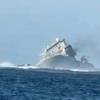New Checklists Improve Speed and Accuracy of ABS Survey
Dynamic checklists will be available to the owner for preparation prior to survey. Then, upon surveyor and reviewer sign-off, completed checklists will become immediately available to the owner through the web-based ABS SafeNet system. “If a surveyor files the report electronically on completion of the survey or audit, it is possible that an owner will be able to view this information before the surveyor has even left the vessel,” adds Pendexter.
The new system also means that owners will be the recipient of positive reporting. They will be able to see which items have been surveyed and found satisfactory. In the past the owner only received exception reports detailing those items that were found unsatisfactory. One dynamic checklist is created for each task (type of survey or type of audit) that is listed on the workorder. In the event that an additional survey or audit is requested later or during attendance, the surveyor or auditor can add a task to the workorder while off-line and the appropriate dynamic checklist will be added.
This is possible because checklists for any type of task that the notation and service agreement permits are downloaded onto the surveyor or auditor's PC at the time the workorder is created. Since the first phase of the dynamic checklist project is vessel-type specific, some check items will be applicable to certain vessels of a given type but not applicable to all vessels of that given type. This will be addressed in phase two of the project, expected to be completed later in 2006, that will be vessel specific. Once completed, vessel specific dynamic checklists will contain only those class required items that are specific to that particular vessel for the specific survey that is to be undertaken, together with the relevant Rule requirements for each item. These checklists will be made available to owners at that time.
It will also be possible for the surveyor to append sketches and photographs to the report that can be viewed by the owner and that will enter the survey record of the vessel.










